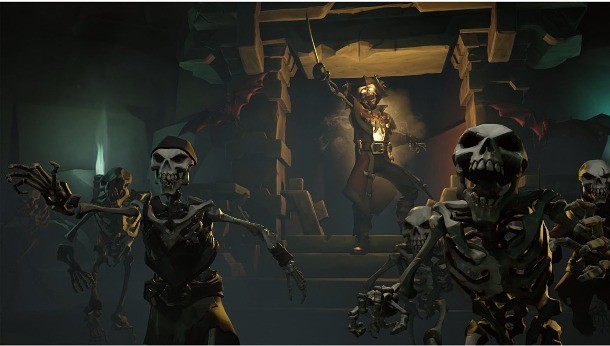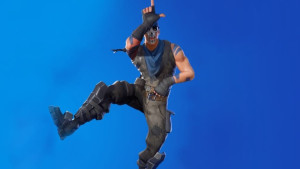Please support Game Informer. Print magazine subscriptions are less than $2 per issue
Opinion – Sea Of Thieves Forgot To Include A Target Audience

I’ve maintained an open mind about Sea of Thieves ahead of launch. On the surface, it ticks a lot of boxes for things I might enjoy. Fantasy setting, beautiful vistas, opportunities for social engagement and cooperation with other players, and leveling and progression with multiple factions. That adds up to a lot of enthusiasm from me, and I suspect a lot of other players may be thinking the same thing.
Perhaps that enthusiasm will prove justified. Our full review (when complete) should provide a comprehensive judgment based on everything Sea of Thieves has to offer. That's not what this is. These are my initial thoughts after one day of playing, and I have to admit to significant confusion regarding who Rare is hoping to ensnare.
It’s Not For Social Players
Game launches are hard, and it’s unfair to judge a game like Sea of Thieves for a shaky first day on the technical side. But even overlooking the half dozen times that the game’s servers dropped for me on day one, there are some more fundamental issues that seem to be far bigger problems.
MMOs, shared world shooters, and other social games in the last 15 years have learned a number of lessons: Make it easy to drop in and out of play. Encourage variable group sizes. Support seamless flow between solo and group play.
Sadly, Sea of Thieves does none of those tasks well. Your player count appears to be set as your session begins, so it’s seemingly impossible to have a friend join up if they arrive late without the entire group quitting to title and starting over. The game ably supports entering the game with a group of any size, but the structure of play means that large crews are simply going to win nine times out of ten – playing as a duo, for instance, is simply a recipe to get cut down by a larger team. And after playing both group and solo activities in equal measures, it’s clear that the solo experience is an afterthought at best – poorly balanced combat, task management that is tedious and slow, and no easy way to join up with other players on the fly as you meet them in the world.
Dozens of other games offer a more robust suite of social controls and gameplay structured around various group dynamics. In comparison, Sea of Thieves feels outdated and unfinished.
It’s Not For Action Enthusiasts
Early looks at Sea of Thieves showed flashing sabers and booming muskets, suggesting combat against undead skeletons and enemy pirates that was swashbuckling and fast-paced. Unfortunately, the final version of combat that I encountered in the first few hours is simplistic and facile. Sword combat lacks any need for finesse, and using the muskets or rifles lacks precision or excitement.
There’s no potential for development or complexity in combat, because battles don’t appear to grow more complex with time. Cosmetic changes to weapons don’t seem to actually change anything about the way battles are resolved, so after many hours, I was still wildly swinging my blade at braindead skeleton enemies. Given that a full third of the proposed missions rely on combat engagement, it feels like a system that needs far greater depth – but it’s just not there.

It’s Not For Kids
Sea of Thieves sports a charming and cartoonish art style that is immediately appealing, and it’s one of the high points of the game. I quite like the visual presentation, and I suspect it would also hold a great deal of appeal for kids.
But the game simply isn’t appropriate for young players. Let’s overlook for a moment that the game allows in-game characters to get drunk on grog. The far bigger issue is the toxic nature of the encouraged play style.
At one point in my day of playing, I spent a half hour sailing to a couple of islands to complete a mission, picking up chests and skulls along the way, which are the primary means for progression and currency acquisition. After one particularly grueling fight on one of the islands, I limped back to my ship with treasure in hand, and pulled myself over the side of the ship just as a cannonball slammed into the side of my ship.
A full crew of four players had decided I was easy pickings, and proceeded to board my ship, steal what I had collected, and murder me. As they did, the proximity-based voice settings (which are on by default) allowed my attackers to shout a string of vile obscenities at me.
Now, far be it for me to question anyone’s enjoyment of these kinds of cutthroat tactics. The game is called Sea of Thieves, after all. But I couldn’t help but imagine what that situation might have been like if I’d been playing Sea of Thieves with my young nephew, and in that moment, I was disappointed to have to cross it off the list of games that I might be willing to play with him. And I certainly wouldn’t want him playing it by himself if that’s the tenor of the community in the game, and the style of communication and interaction that the developer is encouraging through the game’s design.
It’s Not For Power Levelers
I’m always enthusiastic about the potential for leveling up a character. That experience, rooted in the RPGs I played as a kid, communicates a sense of growing mastery and increased options. But Sea of Thieves’ faction-based leveling failed to get me excited in the first several hours of play, as the rewards felt out of step with the time investment required to attain them. And even when you do, the pure focus on cosmetics and a completely flat power curve make it hard to feel motivated.
When playing, would-be pirates can choose one of three distinct factions to level, each of which provides its own type of mission and potential rewards. After a day of playing, there’s some evidence that later missions/voyages supply better rewards and more interesting adventures. But the early tasks are exceedingly boring, easily on the same tier as the most tedious of MMO fetch quests that have been largely abandoned by the very games that first introduced them more than a decade ago.
Even if you go through the motions of these early voyages, the rewards are paltry and slow paced, and the individual items you can buy (like a new hat, or a cooler looking gun) are exceedingly expensive in comparison with the time investment required. Undoubtedly, higher tier missions must certainly improve the pace of currency rewards, but the early hours of play left me feeling like I’d gotten nowhere and gotten nothing good for my time.
Meanwhile, the level progression doesn’t feel like it matters. Factions feel like a wall, preventing me from getting to potentially more complex and interesting missions that might open up later on. I’m stymied as I try to figure out why I should care about continuing to play, as I don’t really care about what I might get for passing to the next level.

It’s Not For Explorers
The pirate fantasy is a potent one. Our collective imagination envisions lost coves, secret treasures, and ancient secrets. Sea of Thieves has the bones of a game that might provide all of that, but instead the early hours that I have played felt staged, scripted, and lacking in surprise.
Gameplay is structured around selecting voyages – missions that necessitate visiting one or more islands to complete a task there – and then returning to an outpost to turn in for rewards. Along the way, I’d hoped to find a wealth of strange moments, enticing encounters, and mystical clues. Instead, every mission I went on was depressingly straightforward. On a regular basis, I’d find locations that seemed to beg to be fleshed out – a cave hideaway behind some trees, a mysterious grave, a seemingly out-of-place uncharted boulder out in the middle of the ocean – but they all turned out to be disappointments. Investigating those locales turned up nothing, and it was back to the rote task of hacking apart skeletons, or catching chickens in a coop.
One of the best moments in my day of playing came as I encountered some birds circling a sunken ship. Upon descending, I found a magical chest within its decrepit hull that could be turned in for rewards – but only if I could deal with its bizarre curse, which made me feel drunk every time I picked it up, causing my character to weave around the ground, and act confused. The game desperately cries out for more emergent moments like this one, but they seem few and far between.
I hope that the later hours of Sea of Thieves reveals a greater depth to its universe – as it’s certainly a beautiful game world to behold. But my first day of playing left me with a bad taste, as if all these islands were a Potemkin village, purporting to hold adventure and excitement, but in reality presenting nothing more than a façade.
Sea of Thieves has an entrancing art style and an intriguing premise, and the potential of some exciting adventures are apparent in the game’s structure. And I’d love to learn that the later hours of the game transform the experience and blossom with complexity. But after one day of playing, I felt like Rare’s latest release was contriving to waste as much time of mine as it could with tedious activities, half-baked mission systems, punishing social dynamics, and none of the narrative or contextual framework that might hook me into the world. A more thorough examination may yield greater rewards, but as of now, I simply can’t think of who will be capable of falling in love with Sea of Thieves. It may have an identity as a vaguely whimsical pirate game, but it fails to extend that identity onto the players who might enter its world.










